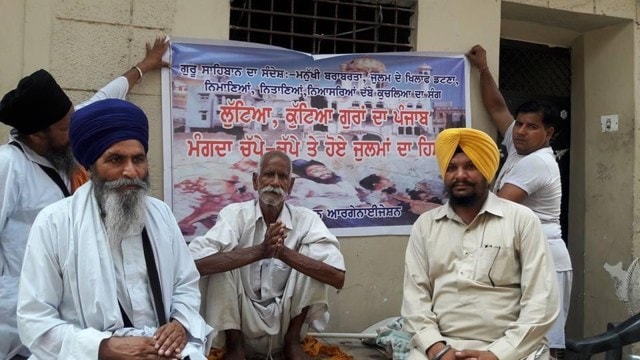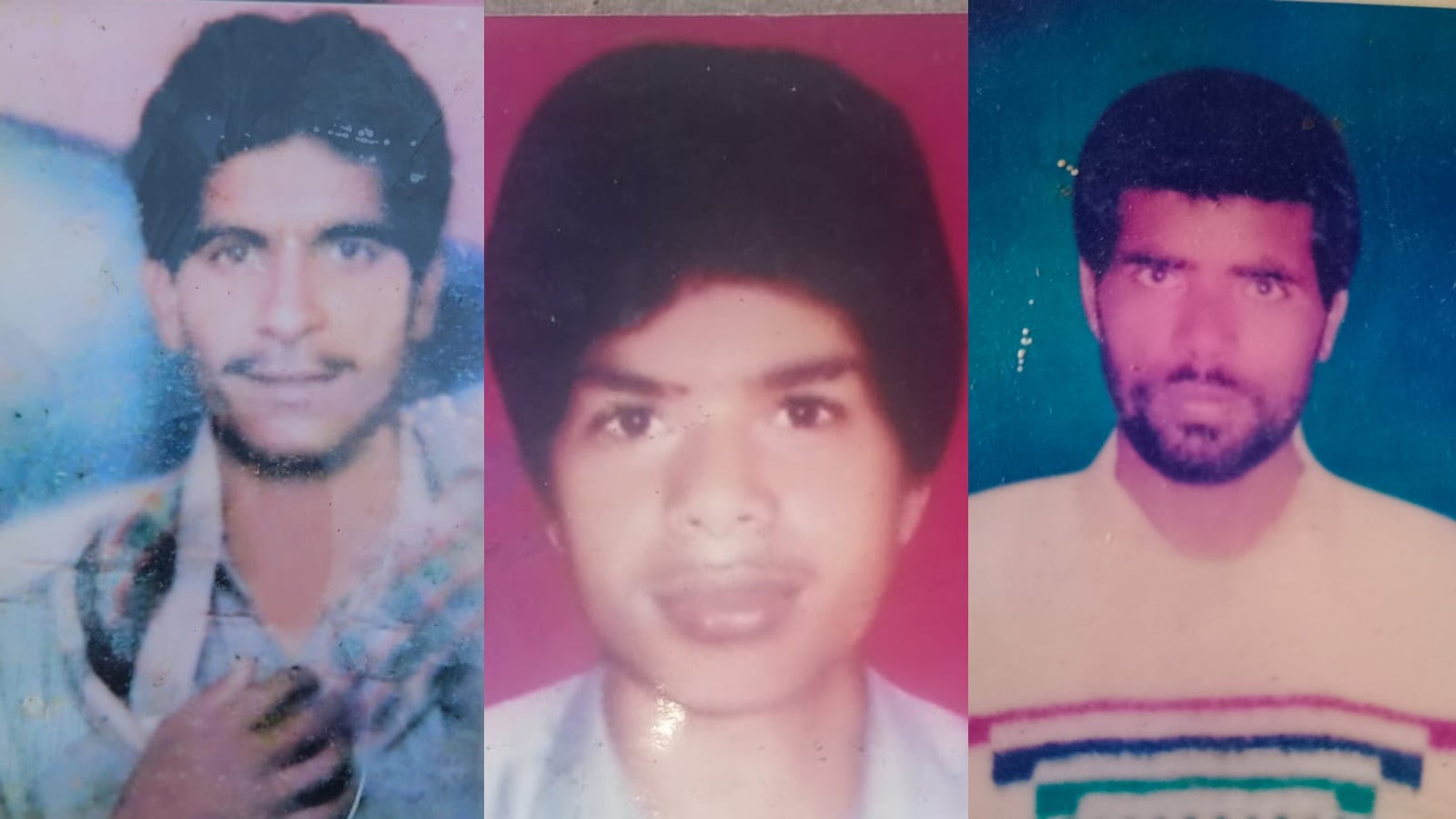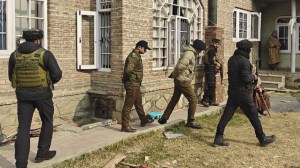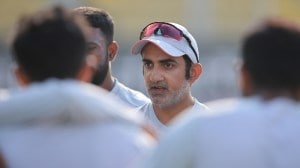A fake encounter in Tarn Taran that refused to die
In July 1993, a young fruit seller and three carpenters were killed and labeled as terrorists by the Tarn Taran police. Over three decades later, the recent court conviction of the guilty cops proves that justice can be delayed but not denied.
 Picture of Chaman Lal, father of Gulshan Kumar, (siting in centre) with human rights activists. (Express Photo)
Picture of Chaman Lal, father of Gulshan Kumar, (siting in centre) with human rights activists. (Express Photo)“When terrorism was at its peak, a union home minister came to Punjab in 1988. He held meetings at the SHO level… Ask them (the government),” said former DIG Dilbagh Singh when questioned about the murder of Gulshan Kumar, 31. Singh was convicted earlier this month for the kidnapping and murder of Kumar, 31 years after the crime.
Last fortnight, the special court of the Central Bureau of Investigation (CBI) in Mohali, under Judge Rakesh Kumar, convicted former DIG Dilbagh Singh and former DSP Gurbachan Singh for allegedly killing Chaman Lal’s son Gulshan Kumar, a fruit vendor. Three other chargesheeted police officers — assistant sub-inspectors (ASIs) Arjun Singh and Devinder Singh, and sub-inspector (SI) Balbir Singh — died during the trial.
Gulshan, the eldest of four brothers and a sister, was a happy-go-lucky 31-year-old who sold fruits at his vend.
Bobby Kumar, Gulshan Kumar’s brother, narrates how it was on the night of June 22, 1993, a police party led by DSP Dilbagh Singh and SHO Gurbachan Singh raided Chaman Lal’s home on Jandiala road in Tarn Taran. “We were sleeping in our house at about 10:00 pm when a police party including DSP Dilbagh Singh and SHO Gurbachan Singh entered our house, caught Gulshan Kumar, and started beating him. They searched our house, then detained all of us, including my sister, and made us sit in the police vehicle. My sister was left after neighbours protested. Gulshan Kumar was made to sit in a separate vehicle, and we were taken to police station Sadar,” recounted Bobby Kumar, who has been pursuing the case along with his brother Praveen Kumar, who passed away last year.
The next day, neighbors and locals Amar Singh, Gian Singh, Manjeet Singh, Manohar Singh, Hardeep, Manohar Lal, and others went to police station Tarn Taran following which Chaman Lal and two of his sons were released.
But Gulshan Kumar remained in illegal police custody for nearly a month. “DSP Dilbagh Singh demanded Rs. 2 lakh for the release of my brothers, Gulshan Kumar and Balwinder Kumar. Later, Balwinder Kumar was also released, but Gulshan Kumar remained in custody. We used to go to the police station to provide him tea and other eatables for about 29 days. I was not allowed to meet Gulshan Kumar but used to see him from a distance,” recounts Bobby Kumar.
It was a month later on July the family learnt from newspapers that Gulshan Kumar had been killed in a fake encounter along with three others: brothers Karnail Singh and Jarnail Singh, and their cousin Harjinder Singh, all carpenters. The police labeled them as terrorists and cremated the bodies without informing the families.
After much running around, Gulshan Kumar’s father, Chaman Lal, a small cloth merchant from Tarn Taran, filed a police complaint that led to the Central Bureau of Investigation (CBI) registering the case in 1996. But the case remained in limbo for years, with many witnesses dying during the prolonged trial.
Gulshan Kumar’s case is emblematic of the impunity with which the Punjab police operated during the 1980s and 1990s. Human rights activist Jaswant Singh Khalra, who was later kidnapped and disappeared by the police in 1995, documented many such cases, including that of Gulshan Kumar.
The Khalra Mission Organisation, founded by Jaswant Singh Khalra’s wife, Paramjit Kaur Khalra, and Punjab and Haryana High Court lawyer Rajwinder Singh Bains, continued to pursue the case despite numerous obstacles. The CBI cited 32 witnesses, but only 15 testified as many died during the trial. The first witness statement was recorded 29 years later, on April 25, 2022. Chaman Lal died in 2016 at age 101, but his statement recorded under Section 161 of Cr.P.C. became part of the court proceedings.
Among the witnesses who testified was Amar Singh, a neighbor and eyewitness to the kidnapping of Gulshan Kumar and his family by a police party led by then DSP Dilbagh Singh.
 Gulshan Kumar , Karnail Singh and Jarnail Singh. (Express Photo)
Gulshan Kumar , Karnail Singh and Jarnail Singh. (Express Photo)
“My father never wore shoes as he had pledged to wear them only after the murderers were punished. He couldn’t wait for the judgment that came too late. You can’t imagine the kind of pressure we faced to withdraw the case. Our family crumbled under the burden of the case. We could never recover from it,” said Bobby Kumar, adding how his brother Parveen Kumar never married and continued to pursue the case till his death last year.
The June 6 ruling, delivered on the 40th anniversary of Op Blue Star, also provided much-needed closure to the family of Darshan Singh, a Dalit Sikh from Zira in Ferozepur district. Of the three other youngsters killed in the encounter, two, Karnail and Jarnail, were his sons and Harjinder his nephew.
Though unrelated, Chaman La and Darshan Singh were united by their loss.
Nirvail Singh, the brother of Karnail and Jarnail Singh, who were killed in the same fake encounter, had an almost identical experience but the case was never taken up as no police complaint was filed. Nirvail says, “Police never told us why we were arrested. My father, Darshan Singh, got me released from the police. Officers demanded Rs. 2 lakh for the release of my brothers and cousin. Thereafter, my father and I used to go to PS City Tarn Taran to provide food to my brothers and cousin.”
Despite the convictions, the delayed justice highlights systemic issues within the law enforcement system. Gurbachan Singh, who received life imprisonment, and Dilbagh Singh, who received a seven-year jail term, had both been honoured with gallantry awards during their service.
The Supreme Court had stayed proceedings in several similar cases, including that of Gulshan Kumar, until 2016, the year Chaman Lal passed away.
How cops violated rules
Violating basic and mandatory procedures, the dead bodies of four individuals were not preserved for identification for 72 hours, as police termed them unidentified.
Gurbachan Singh admitted during cross-examination that the bodies were cremated on the same day. Harbhajan Singh, near whose fields the police had shown the alleged encounter, told the court that no such incident had taken place near the drain or his land.
Post-mortem reports prove that three persons died due to firearm injuries, and surprisingly, all the bullets hit the heads of all deceased persons.
According to the police FIR, during the dark night, the accused/deceased fired at the police party, and the police fired back in self-defense. The bullets hit only the heads of the deceased who tried to flee, but none from the police party was injured in this incident.
Dr. Karnail Kaur, who conducted the post-mortem of Gulshan Kumar reported that a single bullet was aimed at the right temporal region of the scalp.
The CBI told the court that in a real encounter, such precise injury is extremely rare. The post-mortem report of the second deceased also showed one firearm injury on the right frontal region of the skull.
The post-mortem of the third so-called terrorist also showed a healthy body with just one firearm injury on the left temporal region of the skull. Again, it was a precise hit on the head with the intent to kill.
The small size of the entry wound indicated the shot was fired from close quarters. The deaths in each case were instantaneous.
The CBI drew parallels with the encounter of freedom fighter Chandra Shekhar Azad at the hands of British police to highlight the gross loopholes in the theory of the encounter that police presented.
 Pictures of Chaman Lal (white headgear) with Darshan Singh holding a handwritten playcard to demand justice. (Express Photo)
Pictures of Chaman Lal (white headgear) with Darshan Singh holding a handwritten playcard to demand justice. (Express Photo)
“Even in the famous case of patriot Chandra Shekhar Azad, he was killed in a real encounter; he was fired at repeatedly before the police approached the body. In every real encounter, the suspects don’t die like ducks, and this has been the experience of police forces around the country for decades. These post-mortems prove one thing certainly: that they are in harmony with the oral evidence of abduction, illegal detention, and thereafter enacting a fake encounter,” the CBI stated in its chargesheet against Punjab police.
Accused Gurbachan Singh, then SI/SHO of PS City Tarn Taran, claimed that 32 cops participated in the encounter.
However, he only recorded the statements of SI Balbir Singh, and HC Harjit Singh u/s 161 Cr.P.C from the police party after the encounter. There was no mention of the weapons in possession of 32 members of the police party, how many rounds were fired by the police party, details of empty cartridges/shells recovered from the site, the number of police vehicles used, or the names of drivers.
No forensic expert was called to the spot. As per the police FIR, SP laid an ambush/naka at 3:00 am on 22.7.1993, and the alleged encounter took place between 4:30 am and 5:00 am, but ruqa (report) was sent at 7:30 am, after a delay of 2 hours. More interestingly, the police station is 3 km from the alleged place of occurrence.
Tales of Fake Encounters in Punjab
In the 1990s, Punjab witnessed numerous fake encounters, leading to several convictions of police officers by the CBI. Following a Punjab and Haryana High Court order on December 11, 1996, the CBI registered 32 cases of kidnapping, forced disappearance, and fake encounters.
The CBI also published an advertisement in newspapers seeking complaints-cum-affidavits from the public, receiving a total of 199 responses, which were subsequently scrutinized.
According to records, the CBI registered 62 cases related to these issues. Of these, 46 cases were from Amritsar, Tarn Taran, and Majitha districts, with the remaining 16 from other districts. Upon completing the investigations, charge-sheets were filed in 46 cases, while 16 resulted in closure reports. Out of the 46 charge-sheeted cases, 24 ended in convictions, six in acquittals, and 16 are still pending before the trial courts.
Justice in these cases was delayed by 10 years due to a stay imposed by the Supreme Court in 2006, which was only lifted in 2016.
Earlier this year, the CBI provided these details in response to a fresh petition from the Punjab Documentation and Advocacy Project (PDAP) filed in the Punjab and Haryana High Court. The petition demanded an investigation into approximately 6,733 alleged enforced disappearances, extrajudicial killings, and illegal cremations in Punjab between 1984 and 1995.
The National Human Rights Commission (NHRC) had previously addressed similar issues. In an order dated November 11, 2004, the NHRC held the state government vicariously liable and awarded compensation of Rs. 2.50 lakhs to the next of kin of victims who had died in police custody. Additionally, on April 3, 2012, the NHRC ordered monetary relief of Rs. 1.75 lakh to the next of kin of each deceased person who had been cremated by the state of Punjab without adhering to Punjab Police Rules, guidelines, practices, and humanitarian law.







